More than a mile deep, up to 10 miles wide and 277 river miles long, the Grand Canyon is one of the world’s most breathtaking wonders. Located in northern Arizona, this remote area lures more than six million people each year, making it America’s second most-visited national park.
Because the Colorado River bisects the park, facilities on each rim of the canyon are distinct and distant from one another. The more popular and accessible South Rim sees 90 percent of the visitors. The North Rim is more isolated, 1,000 feet higher and, unlike the South Rim, closes during the winter. To go from one rim to the other requires a 220-mile drive around the main canyon.
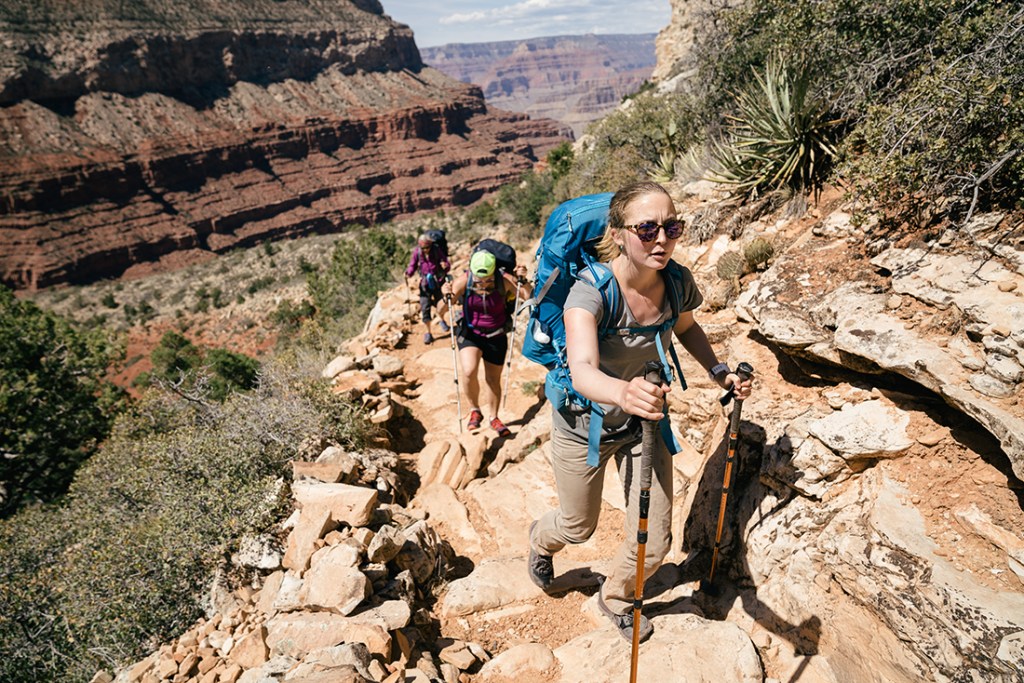
Backpackers ascend a trail in Grand Canyon National Park.
At first, visitors to the park are inevitably drawn to one of the rim overlooks, but for a more immersive experience, you can also explore the park in other ways, like camping, day hiking, backpacking, bicycling or taking a river trip.
You have many options for exploring the park, but to help sort out the choices, here are some suggestions that take you away from the crowds, down into the canyon and out into the surrounding desert.
Camping in Grand Canyon National Park
The park has three car-accessible National Park Service (NPS) campgrounds, offering more than 450 total campsites. Two campgrounds can be reserved (reservations are available up to six months ahead of time), while the third is entirely first-come, first-served. A primitive North Rim campground, reservable by backcountry permit, is an option for those with four-wheel drive who want to escape the crowds.
You can reserve campgrounds inside the park (as well as those on National Forest lands outside the park), by using the national recreation.gov website or by calling 877-444-6777.
South Rim Camping
Mather Campground (327 sites, reservable): Located in the busy Grand Canyon Village area, this isn’t the place to escape the crowds. It’s the biggest campground in the park, though, and one of the few campgrounds you can reserve in advance.
Because the South Rim is open year-round, the campground is open year-round, too. While not required, from March 1 through the end of November, making reservations is strongly recommended. During the rest of the year all sites are available on a first-come, first-served basis.
Desert View Campground (50 sites, non-reservable): Located at the east entrance of the park, 26 miles east of Grand Canyon Village, this is your quieter camping option on the South Rim. The campground is open from the middle of April through the middle of October on a first-come, first-served basis.
North Rim Camping
North Rim Campground (90 sites, reservation-only): If you want to camp inside the park on the North Rim, this is your only option that doesn’t require a four-wheel-drive vehicle. The campground is open from May 15 to October 31, though severe weather, especially late in the season, can affect road access and the availability of drinking water.
Tuweep Campground (nine sites, reservable via backcountry permit): This destination has no water and is so remote you need a backcountry permit to reserve a site. This is also a camping destination that requires you to have a four-wheel-drive, high-clearance vehicle because all the roads that access it are primitive, punishing and no less than 50 miles long.
The big draw to camping at Tuweep is the Toroweap Overlook, a short hike from the campground. Here you can stand at the edge of the rim next to a sheer 3,000-foot drop down to the Colorado River.
Although you can get permits year-round, that doesn’t mean roads to the campground are always passable. A reservation is $10, plus an $8 per night camping fee.
Hiking and Backpacking in the Grand Canyon
The Grand Canyon presents unique challenges to hikers, including extreme heat, high altitude, steep trails and route-finding dilemmas. Even if you are an avid hiker, you will find the Grand Canyon to be very different from most of your other hiking experiences.
For starters, you won’t really find truly “easy” options unless you take one of the rim-side trails. Most hikes follow an “inverted mountain” scenario, where descent comes first and grueling uphills come at the end, when you’re most fatigued.
Check out the park service’s hiking tips and summer hiking pages to learn about how to prepare for canyon hiking and also special concerns of the trail.
Backcountry Permits: Each year the park receives many more requests for backcountry permits than it has available. A limited number of last-minute permits are issued, but you really need to plan ahead. The earliest a permit request can be submitted is the first day of the month four months prior to your proposed start month. Check the backcountry permits page for full details.
For more information on planning day hikes and backpacking trips, visit the Grand Canyon National Park backcountry trails page.
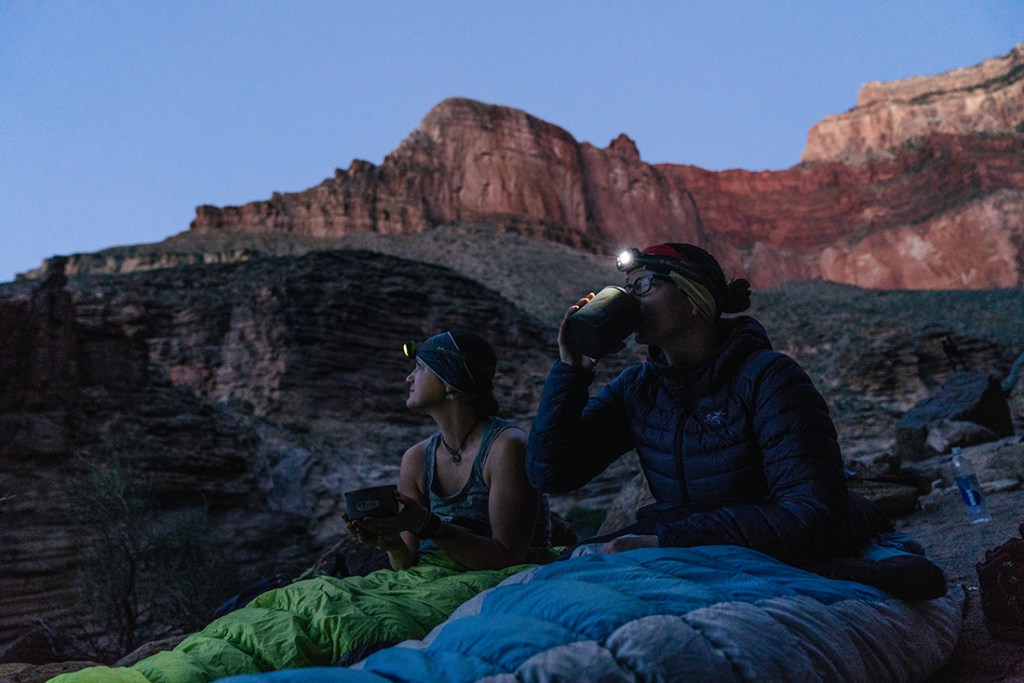
The Grand Canyon offers top-notch stargazing, but remember to pack for the cold desert nights.
You can choose from a variety of trails, including the well-traveled, well-maintained corridor trails—South Kaibab, North Kaibab and Bright Angel Trails. They meet at Phantom Ranch, where the park has its only footbridge across the Colorado River.
To find some less-traveled gems, we talked with REI experts at the Flagstaff, Arizona, store, who shared a few of their favorites.
Recommended Hikes
Hermit Trail to Dripping Springs Day Hike (easy to moderate; 6.5 miles round-trip): Typical of canyon hikes, elevation down and up (about 1,500 feet) is more impactful than the trail mileage. This trail isn’t frequently traveled, but you’ll still encounter a few people along the way. If you look carefully as you hike, you’ll see fossil footprints in the Coconino sandstone as you make your way down the switchbacks.
Begin by taking the shuttle bus from Grand Canyon Village to the Hermit’s Rest trailhead. The shuttle runs March 1 to Nov. 30; for hikes between Dec. 1 and Apr. 30, you’ll need to drive to the trailhead. The hike follows the Hermit Trail for 1.5 miles, where there is a junction with the Dripping Springs Trail. Turn left and follow the trail, passing a junction with the Boucher Trail, reaching the springs in another half mile. Dripping Springs often has beautiful monkey flowers growing all around it.
Grandview Trail to Horseshoe Mesa Day Hike (moderate; 6.5 miles round-trip): The beginning part of this hike is very steep, with a level of exposure that some hikers find uncomfortable. The grade comes from the trail’s origin as a route for early prospectors, whose copper mines you see along the trail. Your elevation change is about 3,000 feet on the trip and overall mileage varies, depending on how many trails you explore when you reach Horseshoe Mesa.
The hike also features interesting geology. Red, gray and orange layers on the opposite side of the canyon are part of the “supergroup,” a rock formation that fills in about a billion years of geologic history. Found in few other areas of the canyon, it is one of the only rock exposures from its time period in all of North America.
To reach this infrequently traveled trail, drive east from Grand Canyon Village 12 miles to Grandview Point, parking in the upper lot. Fill up with water here, because the next source is at the bottom of a long downward grind. After your initial descent, a junction with the East Horseshoe Mesa Trail lets you take a precariously steep (and exposed) side trail for three-quarters of a mile to refill at Page Spring (also known as Miner’s Spring). After you return, you can hike out to points along the horseshoe, where you’re treated to magnificent canyon views. To return, retrace your steps back up the Grandview Trail.
South Kaibab/Tonto/Bright Angel Day Hike (strenuous; 13-mile loop): What makes this day hike so grueling is the final 3,000-foot ascent back to the rim. It also makes use of Corridor Trails, so you share portions of the route with groups of hikers and packstock. The lure is the center section, a traverse along the Tonto Trail that rewards you with glorious views of the inner gorge, temples and buttes.
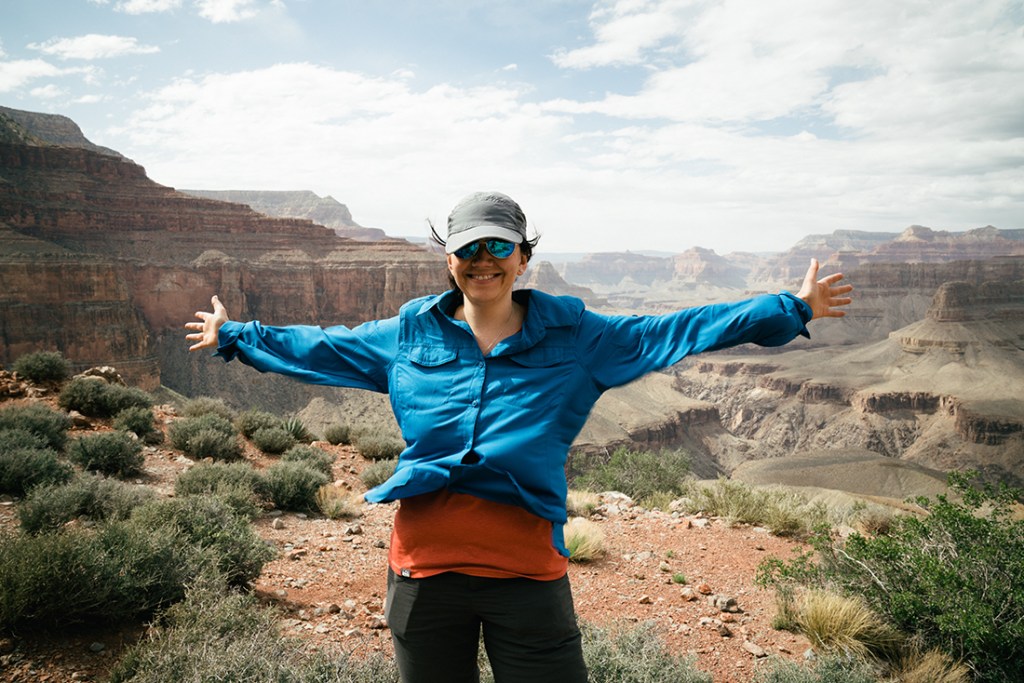
The inner canyon is often hot and dry, so be sure to pack lots of water and bring a hat.
Park at the South Rim Backcountry Information Center and take a bus to the South Kaibab trailhead. When you finish, take a shuttle bus back from the Bright Angel trailhead. It’s best to start at South Kaibab because there’s no water on this part of the hike. This well-trodden route follows the South Kaibab Trail, then left on the Tonto Trail, then another left on the Bright Angel Trail. Each section is slightly more than 4 miles long. On the return trip up Bright Angel from Indian Gardens, water is available seasonally, as well as every mile and a half as you hike up.
Horseshoe Mesa Backpack (moderate; 12-mile loop): The numerous trails on Horseshoe Mesa offer many variations, including a side trail to Cave of the Domes, the only Grand Canyon cave that doesn’t require a special permit to enter. Be aware that many of the side trails in this region are steep, exposed and sketchy, and wayfinding can be challenging. If you plan to camp at Cottonwood Creek, call the Backcountry Information Center (928-638-7875) beforehand, because this creek runs seasonally.
To begin this hike, drive east from Grand Canyon Village 12 miles to Grandview Point, parking in the upper lot. Fill up with water here, because the next source is after a 3.75-mile hike and a 3,000-foot descent.
After reaching Horseshoe Mesa, go right on the East Horseshoe Mesa Trail. Pass a mine with a lot of old equipment and Page Spring (also known as Miner’s Spring) on the way. At Hance Creek, camp under a huge cottonwood tree. The next day, hike on the Tonto Trail as it contours counterclockwise around Horseshoe Mesa, enjoying beautiful views along the way.
Take the next junction toward Cottonwood Creek, where you can camp for the night. That means the final leg of the hike gains more than 3,500 feet, climbing Cottonwood Creek to the Grandview Trail, then all the way to the rim. For beautiful canyon views, you can detour out to the points of the mesa before starting the final climb to the trailhead.
Bill Hall Trail/Deer Creek/Thunder River Backpack (strenuous; 23-mile loop): This five- to seven-day North Rim sojourn, like most backpacking trips, requires good wayfinding skills, especially on the way out. It’s a great hike for early or late summer (never in the heat of mid-summer, though) as there is so much water to play in.
Tapeats Creek/Thunder Falls and Deer Creek are popular rafting destinations, so areas near the river are heavily trafficked by day. Rafters aren’t allowed to camp here, though, so nights can be quite peaceful.
Sights to see: Thunder river spring is basically a fire hydrant’s worth of water pouring out of the side of the rock. From both Thunder River campsites and Deer Creek campsites you can hike down to the river. Deer Creek also has Native American handprints to check out as you hike along the narrows. Deer Creek spring has a waterfall you can sit behind and the intriguing “Throne Room,” an area of rock chairs built up by hikers many decades ago.
In good weather the forest roads to the trailhead are reasonable in a regular vehicle. Five backcountry camping areas are available, with Deer Creek being especially popular with permit seekers. Regardless of the route you choose, consider caching water along the Bill Hall trail to help on your long, dry hike back up to the car.
Other Ways to Explore the Grand Canyon
Canyoneering: This niche sport involves rappelling into slot canyons and hiking, scrambling and perhaps swimming to make your way back out. Though less technical than other climbing-related disciplines, it requires proper training and specialized gear. If you’re interested, take an introductory canyoneering class. Check with REI stores and outdoor clubs, especially those in the southwestern U.S.
River trips: Rafting the canyon for many is a once-in-a-lifetime adventure and dozens of companies are set up to take you. The full canyon is a multiweek trip, though shorter tours are also available. It’s also possible to paddle the canyon on your own, but, even if you have the requisite whitewater skills, navigating the weighted lottery system is a significant undertaking in and of itself. Full details are on the river trips / permits page.
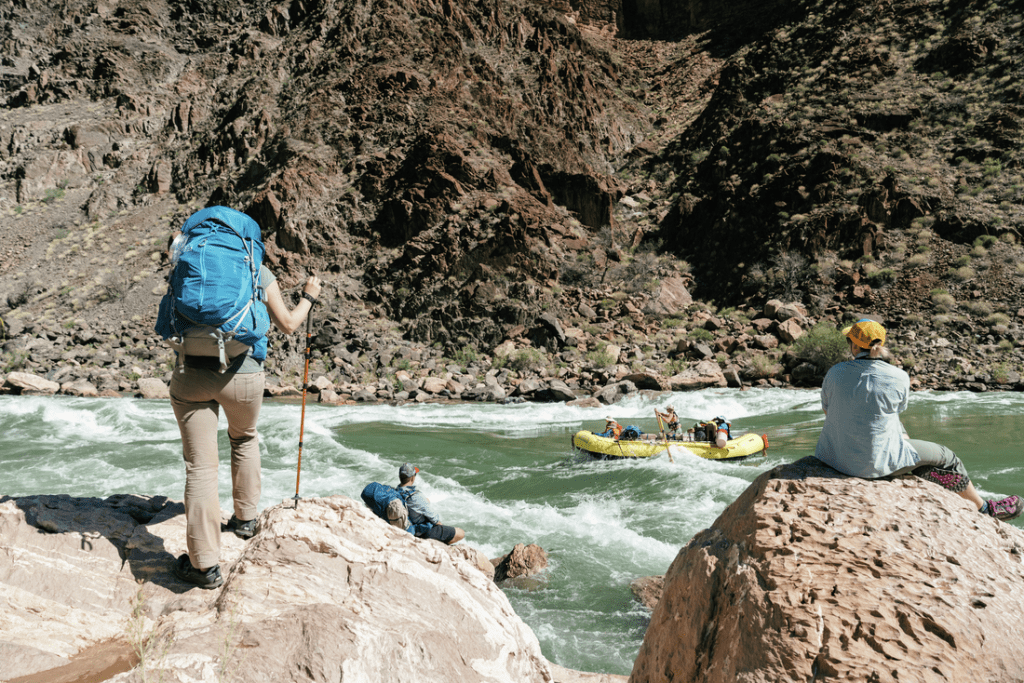
Both hiking and rafting are popular activities in the Grand Canyon.
Cross-country Skiing and Snowshoeing: Because areas of the park are open year-round, you can experience profound solitude when the canyon transforms into a world of sandstone and snow. A winter visit requires proper gear, cold-weather camping experience and a backcountry permit. Pay close attention to weather reports and be prepared to drive and travel on foot over snow and ice. North Rim facilities close in winter, but access is available by cross-country skiing or snowshoeing over long distances. You can also reserve the six-person North Rim Yurt for your winter adventure.
Biking: Most roads in Grand Canyon National Park are open to cycling, but road shoulders are narrow and vehicle traffic is heavy. The park has no mountain bike trails, and no bikes are allowed below the rim.
One good cycling option in the park is the Hermit Greenway Trail, a 2.8-mile paved route along the rim. Riding South Rim roads like the Hermit Road when they are closed to private vehicle traffic is also enjoyable because you share the road solely with shuttle buses. Bike racks on the buses allow you to do one-way rides.
For more information, visit the Grand Canyon National Park Bicycling page or Bright Angel Bicycles, a private company that rents bicycles in the park.
Fishing: In conjunction with its Comprehensive Fisheries Management Plan, the park service is removing non-native fish species and allowing some fishing in the park. For details about licenses and fishing regulations, call the Arizona Department of Game and Fish at (602) 942-3000.
Tips for Visiting the Grand Canyon
Getting to the Grand Canyon
One of America’s most remote national parks, the Grand Canyon is in the northwest corner of Arizona, close to the borders of Utah and Nevada. The Colorado River that bisects the park creates two distinct areas, and you’ll need to plan your visit accordingly. See the Where is Grand Canyon Page for information about the South and North Rims and about traveling to the region.
Grand Canyon Fees and Passes
Fees for entering the park depend on the type of pass you choose and your vehicle. You can opt for a single-use park pass. Other options include an annual parks pass, or the America the Beautiful Interagency Annual Pass that covers all national parks and federal fee areas. For full fee details visit the fees and passes page.
Weather, Road Conditions and Visiting Tips for the Grand Canyon
Be prepared for extreme heat and sun exposure any time; thunderstorms, bringing the threat of both lightning and flash floods are most common in summer, but can occur year-round. Temperatures in the canyon can be 20° warmer than at the rim.
Spring and fall are the most popular seasons. July and August, when temperatures exceed 120° Fahrenheit at the Phantom Ranch Colorado River crossing, are too hot for many activities, especially backpacking. Winter lets you avoid crowds, but road closures are an issue and you need to be prepared to drive and travel over ice and snow. To avoid crowds in other seasons, head to the North Rim, where just 10 percent of all canyon visitors go.
Weather and Road Info: Call 928-638-7496 for weather and road-closure details. For forecasts and details about park weather and road conditions, visit the Grand Canyon Weather and Road Conditions page.
Grand Canyon Guidebooks and Maps
The park service website and its Grand Canyon Trip Planner are excellent resources. A number of other websites also focus specifically on the park. Guidebooks and maps can be found at the REI Flagstaff store. Another great resource is the guidebooks and maps section of the Grand Canyon Association.
Lodging
The park has five year-round lodges on the South Rim and one North Rim lodge that closes in the winter. Backcountry users can also stay at Phantom Ranch by the Colorado River. Communities outside the park also offer lodging, some even provide shuttle service to the park. For reservation info (book well in advance) and other details, visit the park’s lodging page.
Food and Supplies in Grand Canyon
The South Rim has an abundance of restaurants and other food options, including options outside of the main village at both Hermit’s Rest and Desert View. The North Rim also has several meal providers. For full details visit the park’s restaurant page. For details about fuel and other necessities, visit the park’s goods and services page.
Special Concerns in the Grand Canyon
Food Storage: You won’t find bears here, but you need to protect food from rodents and ravens. Three backcountry sites—Bright Angel, Indian Garden and Cottonwood campgrounds—provide metal storage containers and their use is mandatory. For other sites, you’ll need a “rat sack” or other storage canister. Place aromatics, like soap and toothpaste, in the storage container with your food. Undo all pack zippers, so rodents won’t have to chew through pockets to verify that your pack has no food.
Thorns and Stickers: Seemingly every plant has them, so consider a closed-cell foam mattress to sleep on, or pack a pad-repair kit and know how to use it.
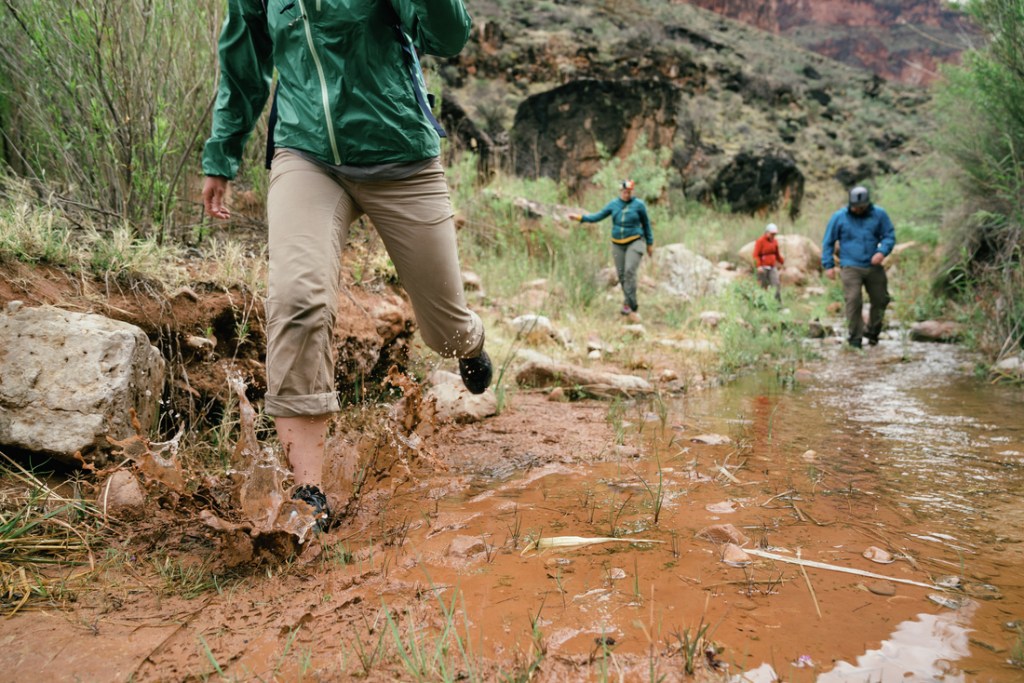
Conditions in the Grand Canyon can be muddy, so choose your footwear wisely.
Drinking Water: Most first-time canyon hikers underestimate how much they’ll need. Pack along (and drink) gallons of it, along with electrolyte drinks, and know where reliable water sources are on your route. All water needs to be treated, too, especially Colorado River water, which gets heavy use from rafters. Packing a prefilter and extra filters is wise, too, because of the water’s high silt content.
River Hazards: If you plan to cool off in the Colorado River, be mindful of currents and hypothermia. Waterflow is controlled by upriver dams that keep rapids high and temperatures low. The currents of the Colorado River are incredibly powerful, so caution is heavily advised.
Thunderstorms: Flash floods, especially in narrow side canyons, are a concern after thunderstorms. Watch the horizon, because a storm that falls above you, even if it never falls on you, is a bigger concern. Lightning strikes, especially in summer, are another hazard. Read the weather dangers page for more details and links to weather reports. Check those weather reports before heading out and move away from the rim and open areas if you’re caught out in a storm.
(REI Flagstaff Sales Manager Madeleine Bryant contributed to this article)
